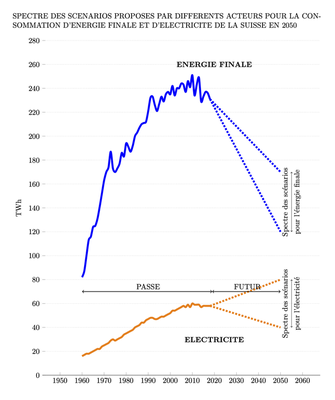Are there alternative energy scenarios to those of Federal Government?
Numerous alternative energy transition scenarios to those of the federal government have been proposed, the most important being those of the Swiss Electricity Association, the SwissCleantech Association, the Energy Agency for the Economy and the Swiss Academies of Sciences, as well as those of two federal parliamentarians, Rudolf Rechsteiner and Roger Nordmann. These different scenarios differ in four main respects: the estimated level of energy consumption in 2050, the rate of deployment of renewable energies, the role of gas-fired power plants in Switzerland, and the importance of electricity imports.
As far as consumption is concerned, the scenarios agree that final energy demand will fall drastically, from 250 TWh today to around 116-177 TWh in 2050, depending on the scenarios [→ see figure below]. The significant differences between these scenarios are mainly due to the different assumptions used regarding the framework conditions of our energy policy, as well as the uncertainty regarding our economic and demographic development [→ Q9].
There is also a great deal of uncertainty as to how our electricity consumption will evolve by 2050. If we consider the most extreme scenarios, one predicts a one-third decrease in our electricity consumption from 60 TWh today to 41, while the other predicts a possible 50% increase to 90 TWh [→ see figure below]. There are a number of uncertainties specific to the power sector that make predictions particularly hazardous, in particular the uncertainties concerning the evolution of electric mobility, the penetration rate of heat pumps, the importance of pump-turbines and the rate of improvement in the energy efficiency of electric motors and drives [→ Q34].
With regard to how to meet this energy demand in the future, there is a broad consensus that energy efficiency and renewable energies are essential ingredients of our future energy system, and that our national potential must be developed. Scenarios essentially diverge on the one hand on the achievable potential of solar and wind energy, and on the other hand on the pace of implementation of these technologies.
The Association of Swiss Electricians (AES) estimates that the deployment of solar panels will be moderate in the coming decades, and that photovoltaic electricity will account for no more than 1 to 2 TWh by 2035, whereas we will probably already have exceeded 1 TWh by 2015! The federal government is only slightly more optimistic, forecasting between 2 and 4 TWh in 2035 out of an estimated realisable potential of 12 TWh. In the optimistic camp, Roger Nordmann estimates that 7 TWh of solar electricity could be produced in 2035, and the SwissCleantech association puts forward the figure of 14 TWh in 2035. Finally, Rudolf Rechsteiner even predicts in his “solar and energy efficiency” scenario that the entire technical potential of solar energy (25 TWh) could be in use by this date. The variation is therefore 24 TWh for solar energy alone between the extreme scenarios. Adding 6 TWh of uncertainty on wind energy, this makes more than 30 TWh of uncertainty on our renewable electricity potential by 2035, i.e. about 50% of our current consumption!
These differences in the potential and rate of deployment of solar and wind power lead to significant differences in our electricity supply shortfall due to the planned shutdown of our nuclear power plants. Depending on the scenarios considered, this deficit varies between 5 and 22 TWh in 2035, and will have to be made up either by building gas-fired power plants in Switzerland (or gas-fired combined heat and power units) or by importing electricity from abroad. The number of gas-fired power plants envisaged (each with a capacity of 400 MW) varies between 0 and 9 depending on the scenario.
In general, the less that gas-fired plants are considered in the scenarios, the more they depend on electricity imports. This highlights the uncertainty about the potential for substitution of renewable energies for electricity generation in the short and medium term. While the federal government intends to limit imports to between 4 and 9 TWh in 2035 and no longer plans to import in 2050, the AES and Rudolf Rechsteiner scenarios assume massive imports: between 18 and 22 TWh, i.e. around one-third of our current electricity consumption. Only Professor Gunziger of the Swiss Federal Institute of Technology in Zurich presents a scenario based on the complementarity of renewable energy sources and seasonal storage, making it possible to make up the winter electricity deficit almost entirely from local renewable resources [→ Q75].
In summary, the different scenarios proposed for electricity supply all use the same two ingredients: energy efficiency (to control the increase in demand), and renewable energy. The differences lie in the weighting of the ingredients, which explains why they sometimes lead to very different visions and conclusions, particularly with regard to the extent of the role of gas-fired power plants and imports in the medium term.

References
- Association des entreprises électriques suisses (VSE/AES) (2012)
- Association des entreprises électriques suisses (VSE/AES) (2012). Electricité photovoltaïque et solaire thermique.
- Barmettler, Franziska and Beglinger, Nick and Zeyer, Christian (2013)
- Barmettler, Franziska and Beglinger, Nick and Zeyer, Christian (2013). Cleantech energiestrategie - richtig rechnen und wirtschaftlich profitieren, auf CO2-Zielkurs. swisscleantech.
- Guzinger, A. (Supercomputing Systems AG) (2013)
- Guzinger, A. (Supercomputing Systems AG) (2013). SCS energiemodell simulation der elektrischen energieversorgungder schweizanhandvon konfigurierbaren szenarien.
- Nordmann (2013)
- Nordmann, R. (2013). Le solaire et la stratégie énergétique 2050 - état des lieux (presented at the Formation Solateur).
- Office fédéral de l'énergie (OFEN) (2018)
- Office fédéral de l'énergie (OFEN) (2018). Statistique suisse de l’électricité 2018. OFEN.
- Office fédéral de l'énergie (OFEN) (2013)
- Office fédéral de l'énergie (OFEN) (2013). Perspectives énergétiques 2050.
- Office fédéral de l'énergie (OFEN) (2019)
- Office fédéral de l'énergie (OFEN) (2019). Statistique globale de l’énergie 2018. OFEN.
- Rechsteiner, Rudolf (2012)
- Rechsteiner, Rudolf (2012). 100% renouvelable - Réussir la transition énergétique vers des énergies propres et accessibles à tous.